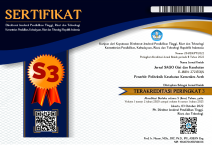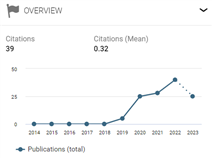Variasi tipe pelarut dan pengaruhnya terhadap kadar flavonoid total daun kirinyuh (Chromolaena odorata) yang tumbuh di kawasan geotermal Ie Seum Aceh Besar menggunakan spektrofotometri uv-vis
DOI: 10.30867/gikes.v6i2.2575Abstract
Background: One plant that can be a source of natural healing for various ailments is the kirinyuh (Chromolaena odorata). This plant can grow in geothermal areas. Plants grown in geothermal areas have the potential to produce higher levels of active substances. The kirinyuh plant is rich in flavonoid compounds. Flavonoids have antioxidant, anti-inflammatory, antibacterial, antiviral properties, and have potential as anticancer agents. The level and quality of flavonoid compounds are influenced by the type of solvent.
Objectives: This study was conducted to determine the total flavonoid content of kirinyuh leaf extract from the Ie Seum geothermal area of Aceh Besar based on different types of solvents.
Methods: Determination of total flavonoid content using UV-Vis spectrophotometry and quercetin was used as a standard in the measurement. Each measurement was repeated three times. The results were analyzed using an independent t-test.
Results: The results of the determination of total flavonoid levels obtained in kirinyuh leaves using ethanol solvent were 10,65 mg QE/g and ethyl acetate was 8,97 mg QE/g. Based on the results of the Independent T-test, a significance result of 0,000 (P<0,05) was obtained. These results indicate that there is a difference in total flavonoid levels between ethanol and ethyl acetate solvents.
Conclusion: The total flavonoid content using ethanol solvent types were higher than ethyl acetate.
Keywords
Full Text:
PDFReferences
Abubakar, A., Yusuf, H., Syukri, M., Nasution, R., Yusuf, M., & Idroes, R. (2023). Heavy metals contamination in geothermal medicinal plant extract; Chromolaena odorata Linn. Global Journal of Environmental Science and Management, 9(4), 995–1004.
Asiminicesei, D.-M., Fertu, D. I., & Gavrilescu, M. (2024). Impact of heavy metal pollution in the environment on the metabolic profile of medicinal plants and their therapeutic potential. Plants, 13(6), 913.
Chang, C.-C., Yang, M.-H., Wen, H.-M., & Chern, J.-C. (2002). Estimation of total flavonoid content in propolis by two complementary colorimetric methods. Journal of Food and Drug Analysis, 10(3).
Harahap, N. D., Dalimunthe, A., & Bangun, H. (2024). Antibacterial activity of tekelan leaf ethanol extract (Chromolaena odorata (L.) RM King and H. Rob) against of Staphylococcus aureus bacteria. International Journal of Basic & Clinical Pharmacology, 13(1), 36–42.
Hardianti, B., Amin, A., Lallo, S., & Hertati, A. (2024). Phytochemical composition by GC–MS, invitro antioxidant, insilico chemical active compound of chromolaena odorata l. weed extract targeting egfr as anti lung cancer. Research Journal of Pharmacy and Technology, 17(12), 6020–6031.
Hu, J., Qi, Q., Zhu, Y., Wen, C., Olatunji, O. J., Jayeoye, T. J., & Eze, F. N. (2023). Unveiling the anticancer, antimicrobial, antioxidative properties, and UPLC-ESI-QTOF-MS/GC–MS metabolite profile of the lipophilic extract of siam weed (Chromolaena odorata). Arabian Journal of Chemistry, 16(7), 104834.
Kato-Noguchi, H., & Kato, M. (2023). Evolution of the secondary metabolites in invasive plant species Chromolaena odorata for the defense and allelopathic functions. Plants, 12(3), 521.
Mokhtar, N., Tap, F. M., Rozani, N. H. A., Khairudin, N. B. A., & Ali, R. R. (2023). Phytochemical profiling, pharmacology prediction, and molecular docking study of Chromolaena odorata extract against multiple target proteins in wound healing. Journal of Herbmed Pharmacology, 12(4), 469–482.
Munira, M., Rasidah, R., Zakiah, N., & Nasir, M. (2022). Identification of chemical compunds and antibacterial activity test of Kirinyuh leaf extract (Chromolaena odorata L.) from Ie Seum Geothermal area, Regency of Aceh Besar, Indonesia. Rasayan Journal of Chemistry, 15(4), 2852–2857. https://doi.org/10.31788/RJC.2022.1548031
Ningsih, P., Pratiwi, N., Supriadi, D. S. A., Tiwow, V. M., Pulukadang, S. H. V., & Rahmawati, S. (2024). Quantification of tannin in chromolaena odorat (kirinyu) leaf extract. Journal Homepage: Http://Iieta. Org/Journals/Ijdne, 19(4), 1341–1346.
RI, K. K. (2017). Farmakope Herbal Indonesia Edisi II. Kementerian Kesehatan RI Jakarta, Indonesia.
Yusuf, H., Husna, F., Gani, B. A., & Garrido, G. (2021). The chemical composition of the ethanolic extract from Chromolaena odorata leaves correlates with the cytotoxicity exhibited against colorectal and breast cancer cell lines. Journal of Pharmacy & Pharmacognosy Research, 9(3), 344–356
Refbacks
- There are currently no refbacks.













